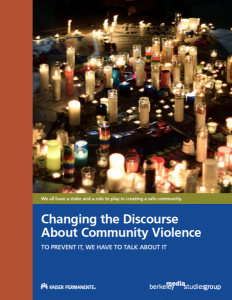What’s missing from news coverage of violence?
by: Karra Gardin
posted on Wednesday, September 21, 2016
This summer, we witnessed the murders of unarmed black men by police across the United States and the frustration, grief and righteous anger that ensued as a result. Using social media, communities effectively captured the emotion and response to the violence and injustice embedded in policing tactics, moving the country to a national dialogue surrounding one of America’s toughest questions: How do we address violence and the complex social and environmental factors surrounding it?
News coverage of crime and violence is an important venue for our society to answer that question. But research has shown that, historically, crime stories have largely neglected to include the community conditions — poverty, structural racism, unequal access to educational opportunity, and more — that foster violence. Without this context, the general public will have a harder time understanding violence as a multi-dimensional issue. Instead, violence will be seen as a one-dimensional problem, often confined within the realm of criminal justice.
Such narrowly focused news coverage has tremendous implications for reinforcing stereotypes about who commits violent acts. It also fosters assumptions that violence is an inescapable norm in society, when in fact, like most other public health issues, there are solutions and ways to prevent future violence. In contrast, when journalists broaden their coverage of violence to include the conditions surround it, the public is more likely to make connections to policies and strategies that can prevent it.
 So, what will it take to change the discourse around violence to elevate solutions instead of feelings of hopelessness? And has news coverage occurring alongside the Black Lives Matter movement begun to shift our understanding of violence in this direction?
So, what will it take to change the discourse around violence to elevate solutions instead of feelings of hopelessness? And has news coverage occurring alongside the Black Lives Matter movement begun to shift our understanding of violence in this direction?
With support from Kaiser Permanente and in partnership with the Prevention Institute, BMSG investigated these questions. To do this, we analyzed the current news narrative about community violence. We reviewed key California media outlets for three years to identify trends in news coverage of community violence and community safety. We found several main themes throughout the coverage:
1. News about individual crimes dwarfed coverage of violence prevention and community safety.
Stories about community violence were much less common than stories about individual crimes. Between 2013 and 2015, articles about individual murder appeared 10 times more frequently than articles addressing violence in the community as a whole. An example of the latter would be a story that pulls back the lens from an individual victim and perpetrator to include the lack of economic and/or educational opportunity, trauma from unstable living conditions, or other social determinants that led to the violent act.We found that when articles were framed around community violence and safety, the discourse included solutions and preventive approaches to stop violence before it occurs. These types of articles highlight the importance of collective action from politicians, educators, community leaders and others to build and maintain safe communities.
2. Criminal justice professionals consistently dominated the news conversation about community violence and safety.
Violence prevention involves health care, schools, businesses, public health and many other institutions. However, speakers from these sectors were largely absent from the conversation about community safety. The majority of speakers quoted in news stories were criminal justice professionals and representatives of state and local government. In 2013, community residents and those directly impacted by violence were quoted in only 1 in 10 articles. When those most affected by the violence are not shaping the story, it reduces the reader’s understanding of the experiences that led to violence. The absence of community residents and speakers from different sectors also reinforces the frame of violence as only a criminal justice issue. A more diverse array of speakers could bring to light the impact of other systems and institutions that led to violence.
3. Local news mirrored nationwide dialogue about racism and community violence.
In previous news coverage, articles typically only mentioned race in passing, e.g. a report that mentioned the race of the young men involved in a murder. However, the motivation for mentioning race dramatically shifted in 2013 after the deaths of Trayvon Martin, Michael Brown and many others that gave rise to the Black Lives Matter movement. In 2015, nearly one-third of articles about community safety discussed race or racism and its impact on community safety. The Black Lives Matter movement likely also significantly changed the media discourse on police reform: Now, instead of framing heavier policing as the sole solution to community violence, news stories often call for addressing racism as a strategy to build safer communities.
So, how can advocates use these results to reframe the discourse around community violence?
The findings reveal the start of a shift in the public dialogue around community violence and safety that advocates can build on to elevate prevention. Advocates can continue to broaden the conversation around violence by building relationships with reporters, expanding the variety of messengers in news about community safety, and pitching stories that require journalists to report on the role that different stakeholders and sectors play in building safe communities. Although changing the narrative around community violence can seem daunting, the recent spike in coverage surrounding gun violence is an opportunity to elevate prevention, multi-sector participation and community leadership.



